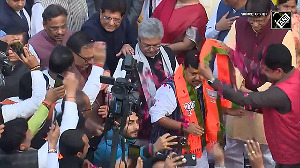With as much as 85 million hectares of arable land being almost wholly rain-dependent for crop production, the vulnerability of the Indian agriculture to the vagaries of the monsoon remains significantly high.
Nearly half of the total acreage of over 90 million hectares under rice, and the bulk of the area under coarse cereals, pulses and oilseeds is unirrigated and hence rain-reliant.
The key to the stability in farm production, therefore, lies largely in stabilising crop output in the rainfed areas.
But, unfortunately, most of the developmental effort in agriculture has remained concentrated in irrigated areas which offered scope for quick results.
The average crop productivity in the rainfed areas has, consequently, remained woefully low at about 1 tonne a hectare, less than half of that in the irrigated areas.
Rainfed areas, moreover, become the worst victims of droughts which are quite common in the country. Their frequency varies in different parts of the country from once in every 2.5 years in Rajasthan to once in 15 years in Assam.
It was to tackle this menace that Prime Minister Manmohan Singh announced the setting up of a National Rainfed Area Authority in his address to the nation on Independence Day in 2005.
However, this authority not only took more than a year to come into being (in November 2006) but has not been allowed to function properly even till today due largely to the inter-ministerial wrangling over gaining control over it.
A group of ministers finally settled the row by putting the authority under the administrative control of the agriculture ministry and making agriculture minister the chairman of the NRAA with the rural development minister as co-chairman.
However, the NRAA's CEO, a technical subject-matter expert, was given the pay scale and rank of the secretary to the government of India but not full-fledge status and powers that go with the job -- the NRAA has been rendered a powerless appendage of the agriculture ministry.
Of its sanctioned staff strength of 53, only 8 posts have been filled and those too by redeploying employees from other departments.
The objective behind creating the NRAA was to ensure convergence, as also to harness synergies, between the rainfed agriculture-related activities being carried out now by as many as five ministries like agriculture, rural development, water resources, panchayati raj and environment and forests. But this hasn't happened as the other ministries do not feel obliged to listen to its sane advice.
It is, therefore, imperative that the NRAA is empowered to enforce its say in all the 5 concerned ministries and that can be ensured only by making it independent and equidistant from all these ministries. To do so, the NRAA should be converted into an autonomous constitutional body.
If that is not possible for any reasons, the other option could be to place this authority in the Planning Commission or, better still, in the prime minster's office so that its writ runs across the ministries.
Revitalisation and needful empowerment of the NRAA has now assumed all the more urgency in view of the proposed move to make it legally binding for the government to provide 25 kg of highly subsidised foodgrains to the poor.
This would require annually anywhere between 40 million tonnes and 60 million tonnes of foodgrains depending on how much of the below poverty line population the government decides to cover under this path-breaking social welfare programme.
Ensuring availability of such huge quantity of grains may not be possible without improving the productivity of the country's vast rainfed tracks.
Therefore, it may be worthwhile for the prime minister himself, whose brainchild the NRAA is, to devote personal attention to this matter and make the authority truly functional to deliver results.






